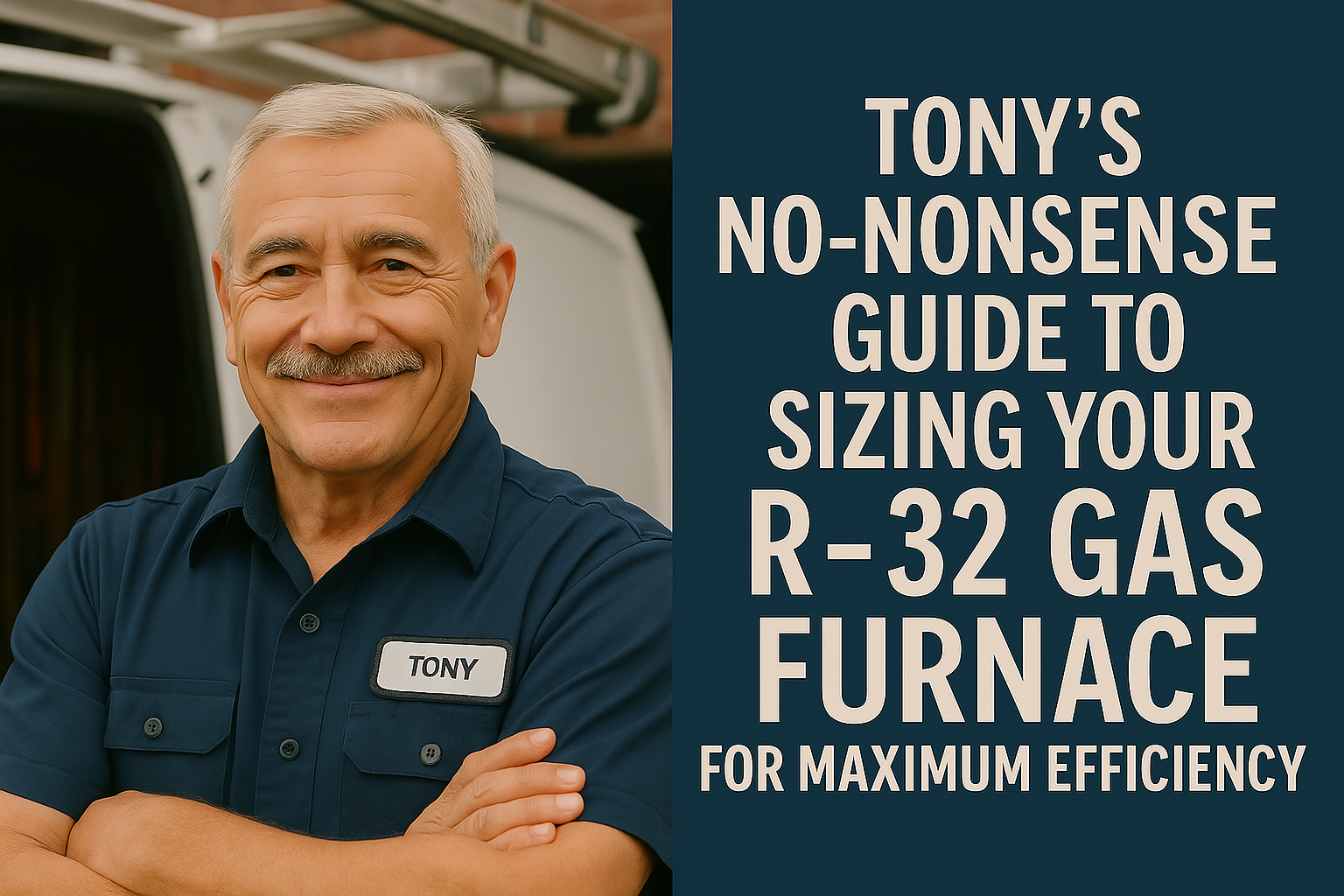👋 Hey there, Tony the Trusted Tech here!
If you’ve ever wondered, “What size furnace do I really need?” you’re in the right spot. Choosing the right-sized R‑32 gas furnace is a make-or-break decision when it comes to comfort, efficiency, and long‑term reliability. Oversized units can short cycle, undersized units can’t keep up, and both can drive your energy bills through the roof.
Today, I’m going to walk you through the nuts and bolts of properly sizing your R‑32 gas furnace. I’ll cover load calculations, BTU ratings, efficiency factors, and how to balance comfort with cost. So grab a cup of coffee, roll up your sleeves, and let’s do this right! 👨🔧🔥
🏁 Why Furnace Size Matters (More Than You Might Think)
First things first: Bigger doesn’t always mean better when it comes to heating equipment. An oversized furnace may:
-
Short‑cycle (turn on and off too quickly), leading to wear and tear
-
Create cold spots due to uneven heating
-
Waste energy and spike your heating bills
An undersized furnace? You’ll feel like you’re living in an icebox.
Rule of Thumb: The right-sized furnace heats your space efficiently, maintains an even temperature, and operates reliably for years.
👉 According to the Department of Energy, a properly sized heating system can save you significant money over its lifetime.
📏 Understanding BTUs and Efficiency Ratings
Gas furnace sizes are measured in BTUs (British Thermal Units).
-
What’s a BTU? It’s the measure of how much heat the furnace can produce.
-
Why it matters? The right BTU rating ensures your furnace can maintain the desired indoor temperature, regardless of the weather.
Modern R‑32 gas furnaces also have efficiency ratings, expressed as AFUE (Annual Fuel Utilization Efficiency). A higher AFUE means more heat goes into your home versus going out the exhaust. According to Energy Star, a furnace with an AFUE of 95% or higher is ideal for maximum efficiency.
🗺️ Factors to Consider When Sizing an R‑32 Gas Furnace
Here’s the checklist I use every time I size a gas furnace:
1️⃣ Home Square Footage
More space needs more BTUs. A general rule is:
-
30–60 BTUs per square foot for cold climates
-
25–35 BTUs per square foot for moderate climates
-
20–30 BTUs per square foot for warm climates
But rules of thumb can be misleading, so I always recommend doing a proper load calculation.
2️⃣ Climate Zone
Location is a huge factor. What works in Miami won’t work in Minnesota. The U.S. Climate Zone Map can help you determine your heating needs.
3️⃣ Insulation and Home Construction
Better insulation and modern windows can reduce the required furnace size.
4️⃣ Number of Occupants
More people = more body heat and activity, which can reduce heating load slightly.
5️⃣ Sun Exposure and Home Orientation
A south‑facing home with lots of windows may need a smaller furnace compared to a shaded one.
6️⃣ Ductwork Quality
Leaky or undersized ducts can affect heating efficiency regardless of furnace size.
🧮 The Importance of a Manual J Load Calculation
For precision sizing, I always recommend a Manual J load calculation — the gold standard in HVAC sizing. According to the Air Conditioning Contractors of America, this method considers:
-
Home layout and design
-
Window sizes and placement
-
Insulation quality
-
Climate zone
-
Number of occupants
This ensures you’re getting a furnace tailored for your space, eliminating costly guesswork.
🔥 Oversized vs. Undersized Furnaces: The Pitfalls
Oversized Furnace:
-
Short cycles, causing wear and tear
-
Higher upfront cost
-
Inconsistent temperatures
-
Increased risk of equipment failure
Undersized Furnace:
-
Struggles to maintain comfort
-
Runs constantly, increasing energy costs
-
Premature wear due to overwork
🛠️ Tips for Getting the Right R‑32 Gas Furnace
✅ Use a Professional for Load Calculation
Even if you’re a DIY warrior, a pro can give you precision results.
✅ Check AFUE Ratings
Modern R‑32 gas furnaces boast AFUE ratings of 95–98%. According to Energy.gov, this can save you hundreds of dollars over the life of the furnace.
✅ Account for Future Renovations
Planning an addition? Finish your basement? These changes can affect your heating needs.
✅ Evaluate Zoning Needs
Consider zoning for multi‑level or multi‑area homes, allowing precise heating and efficiency.
✅ Invest in a Smart Thermostat
Pair your R‑32 furnace with a smart thermostat for precision comfort and improved efficiency.
⚡️ Frequently Asked Questions About Furnace Sizing
Q: What if I pick the wrong-sized furnace?
A: Oversized units short‑cycle and waste energy, while undersized units struggle to heat properly.
Q: Will an R‑32 gas furnace save me money?
A: Absolutely. R‑32 is an eco‑friendly refrigerant that improves efficiency and lowers operating costs.
Q: How long does a properly sized furnace last?
A: When sized and installed correctly, gas furnaces can last 15–20 years.
👋 Tony’s Final Advice: Get It Right the First Time
Look, friends — when it comes to heating your home, precision is worth every dollar. An R‑32 gas furnace is one of the best investments you can make for comfort, efficiency, and reliability — but only if it’s properly sized for your space.
If you’re thinking about upgrading, don’t guess. Get a Manual J load calculation done by a trusted HVAC pro, review your options, and pick a furnace that suits your home and climate. And if you want to explore some of the best R‑32 gas furnaces available right now, check out The Furnace Outlet’s R‑32 Gas Furnace Collection. You’ll find top‑quality units that fit a range of sizes, climates, and needs.
Need more information about venting for your gas furnace? Visit: Tony’s Complete Guide to Venting Your R‑32 Gas Furnace Safely and Effectively.
Remember: It’s better to do it right once than to live with an inefficient, uncomfortable furnace for the next 20 years. Stay warm, stay safe, and stay smart! 👨🔧🔥
- Tony, your HVAC guide







